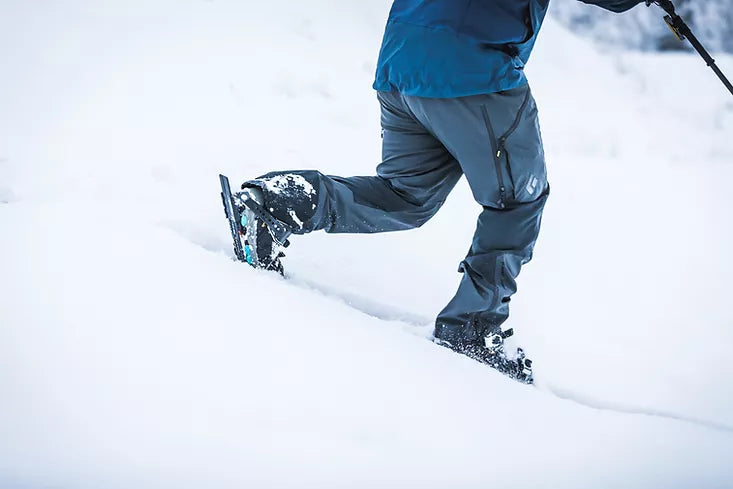
Start with the shoes
Choosing the right kind of footwear for your Skinbased ski outing is critical, as the shoes can really make or break your skiing experience. Even though OAC’s EA Universal Bindings are designed to function with a variety of shoes, there are some restrictions and recommendations you should take into consideration before hitting the snow.
First, consider the sole of the shoe. OAC’s EA Bindings are designed to be used only with flexible-soled footwear. Flexible-soled footwear is any shoe or boot that bends from the front part (toes/ball of the foot) of the shoe. This is important for proper binding function. The binding’s base plate includes a hinge mechanism, and this hinge must be allowed to move freely when skiing is occurring. If a shoe or boot sole is too rigid and the hinge movement is inhibited, the binding’s spring mechanism may detach, or even worse, the binding may break.

Second, check the torsional rigidity (side-to-side support) of your shoe or boot. You can test your footwear’s torsional rigidity by gripping the shoe at the toe and the heel, and twisting the shoe sole laterally, just as if you were wringing out a wet cloth. If it’s hard to bend, then you know your shoe or boot has a great torsional rigidity. The more torsional rigidity your shoe has, the better it is for skiing. Ankle support is equally important. Using footwear with limited ankle support makes controlling the ski more difficult. Thus, we recommend using shoes or boots that have both good torsional rigidity and ankle support.

Our recommendations for Skinbased skiing footwear
Our general recommendations for suitable footwear types include: hiking boots, winter boots, flexible-soled hunting boots, duck boots, gumboots, etc. Footwear types that are not appropriate for OAC EA bindings are: hiking boots with a rigid sole, mountaineering boots, BC and other XC ski boots.
How to correctly fit your binding to your footwear
Now that you have chosen the right shoe for the job, it’s time to adjust the binding to ensure an ideal fit. Achieving a proper fit between binding and boot is easy; simply change the location of the heel unit to a suitable position, then lock it into place. This is accomplished by first lifting the heel unit lever, which opens the locking mechanism. Then, slide the heel unit along the flex plate to the desired location. When in position, press down firmly on the lever until it clicks into place. Now your binding is ready to go.
The ideal binding fit starts with having the heel of your shoe all the way back in the binding, touching the heel unit’s vertical posts. Now, look at the toe area of your binding. Between the front edge of your shoe and the front of the binding, you want to have approximately 0,5–1,0 cm of open space. When you ski, your shoe flexes along with the binding, and this little bit of open space in the front allows the boot to complete these natural movements. If your shoe is too tightly fitted in the binding, it can prevent the heel from rising while you ski, and even worse, it may break the binding.
After you’ve adjusted the length, you can start buckling in. Start with the toe strap. Don’t tighten it too much. If the strap is too tight, the shoe cannot move naturally in the binding while skiing. We recommend leaving enough space for your index finger to fit between your shoe and the strap.
Adjusting the ankle strap depends on the rigidity and the ankle support of your shoe. When you have shoes that are more torsionally rigid and offer a lot of side-to-side support, you don’t need to tighten the ankle straps as tight. However, the less supportive a shoe is, the tighter you need to make the ankle strap. Additionally, your ski style and terrain choice may also affect how tight you wish to wear your ankle straps. If you plan to spend your day charging downhill and skiing in difficult terrain, you are more likely to require better ankle support and thus, will need to tighten the ankle strap more than when you ski on easier or flat terrain. In the end, how tight you wear the ankle straps is up to personal preference, and the only real way to find the right tightness for your purposes is by getting out there and testing it yourself.

OAC’s EA Binding Maintenance
OAC’s EA Bindings are relatively low in maintenance. Below are a few quick tips you can use to solve problems if they start, or prevent problems before they arise.
- From a product performance/longevity standpoint, a binding that squeaks while in use is nothing to worry about. That being said, it can be bothersome to certain users. If your binding picks up a squeak and you wish to reduce or stop it, we recommend applying silicone spray to the moving parts of the binding.
- Your binding is designed to be freeze-resistant and can withstand temperatures down to at least -20ºC. In these colder temperatures though, the straps become stiffer and more brittle. After use in low temperatures, it is important to bring your skis and bindings into room-temperature conditions and allow them to dethaw.
- Occasionally, it is possible to get a buildup of snow in binding’s heel locking mechanism. This could be because the sole of your footwear is too stiff. In some snow conditions, this sort of snow accumulation cannot be prevented, no matter the footwear. In these cases, you may be required to stop and spend a moment clearing out the snow. Afterwards, you can continue again. The use of silicone spray as a preventative can help to minimize this problem.

0 comments